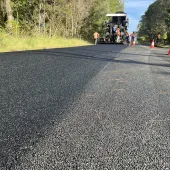Longer-lasting Roads: Bitumen contribution to the sustainability of asphalt

First published in the July 2021 issue of Quarry Management
In this jointly written paper, TotalEnergies’ bitumen division market development manager, Rick Ashton, and technical manager, Gary Schofield, explore the sustainability and durability of asphalt additives and their role in the drive towards net-zero carbon
The current climate that UK local authorities are working under is creating challenges on many fronts that appear to be difficult if not impossible to solve. Budgets are being continually challenged by competition for funding due to societal demands and the impacts of COVID-19. At the same time, the ALARM survey continues to report a deterioration in local road conditions that desperately need to be addressed, as a sound road infrastructure is key to economic recovery, coupled with the fact that the local road network remains the country’s biggest asset.
One of the main problems is local authority highways funding is annualized, which does not encourage forward planning and effective asset management. A rolling five-year funding model, as seen on the strategic road network (SRN), could address this short-termism and the focus on reactive maintenance, opening the door for longer-term planning, which, in turn, would result in more durable surfaces – longer-lasting roads.
Not only do local authorities face this financial mountain to climb, but they are also facing the target of net-zero carbon by 2050.
This range of dilemmas facing local authorities can be addressed by manufacturing asphalt that is durable and longer lasting. Making a road surface last longer means the life costs of the road, in terms of money, carbon and emissions, are significantly reduced on all fronts and is a win-win situation. This article looks at potential strategies to achieve this.
Extending pavement life
In situations where there is pressure to reduce carbon footprint, the temptation is to choose the headline-grabbing options, where up-front carbon savings can be made. Whilst this may tick some operational key performance indicators, the question should always be asked: ‘What is the true impact through the life of the road and how does it really impact on the environment longer term?’.
Technologies have been available for several years that can help with this conundrum – products such as premium cross-linked elastomeric polymer-modified bitumen. Total Styrelf eXtreme 100 is a proven product that demonstrates a binder’s capacity to resist the challenges from modern traffic stresses, the current road designs, and the vagaries of the UK weather. Enhanced performance is retained through an extended period on the road, providing ‘sustainability through durability’. The relatively small increased financial cost of the asphalt at application is massively outweighed by the improved performance over an extended design life, providing a reduced unit cost per year in terms of money as well as carbon.
The enhancements in resistance to dynamic deformation, ambient temperature variations, thermally induced stresses and fatigue, coupled with the improved resistance to ageing of the bitumen, means that Styrelf eXtreme 100 binder can make a significant difference to road durability with a relatively small up-front impact.
Extension to pavement life using this type of established process mitigates risk to the client. It means the cost of the pavement in terms of depreciation over time is less than using the traditional paving-grade bitumen approach. Extended durability reduces carbon cost through the life of the road, optimizing return on investment as the maintenance interventions required are reduced. This equates to less production with the associated manufacturing costs and energy impacts. This strategic asset management means public disruption is minimized – a vote winner amongst road users.
Understanding the stresses that the road is likely to be subjected to and understanding the previous failure modes of the pavement allows a quantified design process to be carried out. Binder selection can be optimized to provide the best durable outcome for the specific challenges of the road.
To further enhance the environmental credibility of these solutions, there is the opportunity to combine technologies and utilize a low-temperature version of Styrelf eXtreme 100 with an ECO2 variant. This allows manufacturing temperature to be reduced by up to 40–50°C. The benefits in reduced initial CO2 production coupled with less future manufacturing offer immediate and long-term environmental benefits. Another improvement is in the amount of fuming generated in production and installation, amounting to lower emissions to air; another critical factor in the areas where there are Ultra Low Emission Zones in urban environments.
To optimize the benefits from these technologies, it is vital that the installation follows best practice. Interlayer bond coats such as Total Emulsis NBC, when properly applied, mean that the design assumptions of a monolithic structure are valid. Where these are inadequately applied, there is a chance of unbonded layers creating high strains on the underside of the surface course, which will compromise the longevity of the performance of the surfacing and failure modes such as delamination can ensue. The other area of concern with unbonded layers is the negative influence of water ingress into the structure. Many studies have shown how significant the compromise to durability can be with unbonded layers – up to a 60% reduction.
There are also developing technologies that are focusing on reducing the susceptibility of the bitumen to oxidation, eg products such as Total Styrelf eXtreme 100 Long Life. Under normal circumstances bitumen reacts with oxygen, becoming stiffer over time. This action results in loss of ductility, embrittlement and a reduction in the capacity of the bitumen to relax the strain applied, which means asphalts are more likely to crack. With long-life technology this progression is slowed significantly. In terms of Styrelf eXtreme 100 Long Life, it means the original benefits of the product last longer and so resist the stresses of traffic and the environment for longer. Laboratory testing indicates the onset of ageing can be delayed by up to 30%.
TotalEnergies have been developing the new slow-ageing polymer-modified binder (PMB), which aims to increase the lifespan of roads and reduce the need for roadwork interventions. The binder is now patented and being put to the test in a long-term study with Highways England. A section of the A43 dual carriageway in Northamptonshire has become the first in the country to be resurfaced with the new product Total Styrelf - Long Life.
The UK strategic road network now predominantly utilizes thin surface courses that are generally resurfaced every 10–12 years, as work hardening, UV exposure and oxidation cause the surface to become embrittled and then deteriorate, allowing water ingress and cracking or fretting of aggregate.
Most of these carriageways are designed around a structural design life of 80MSA (million standard axles). During this period the sacrificial surface course can be replaced five or even six times.
The idea of this PMB development is to protect the road surface from the elements so effectively that roads built with it could last for a longer period, reducing the need for surfacing interventions. This increases the sustainability of the road’s whole life cycle. Network asset managers estimate that a 10% increase in durability can remove one surfacing intervention in the pavements design life, saving money, disruption and, ultimately, energy.
Following extensive laboratory research and development, TotalEnergies’ Preston technical team worked in partnership with Highways England and Tarmac to resurface a busy section of the A43 near Silverstone, in Northamptonshire, using the new binder. In November 2020, three sections of the dual carriageway were surfaced, each with the same mixture, one with penetration-grade binder, one with Styrelf eXtreme 100 PMB, currently TotalEnergies’ premium grade, and the third section using the prototype ‘Long Life’ variant of this PMB.
The long-term trial will last up to 15 years as the three sections are benchmarked against each other for ageing characteristics and deterioration modelling. Initial samples from the installation will be used to compare material ageing of the recovered binders both in situ and in laboratory conditions.
Research undertaken prior to the trial utilized accelerated ageing tests using PAV (pressure ageing vessel), MSCRT (multiple creep stress recovery tests) and RTFOT (rolling thin film oven tests) to simulate ageing and its affects in situ (fig. 1). These initial tests on the PMB indicate the ageing profile of binder can be delayed by up to 30%. This is a significant result given the assumption that a 10% improvement could remove one set of road works.
The multi-dimensional graph of performance characteristics (fig. 2) demonstrates the changes in material performance as the two PMBs are artificially aged in the accelerated ageing tests. The parameters of increased softening point, decreased penetration and loss of fatigue resistance or ability to relax strain are demonstrated in the delta between the two products.
The graph predicts the Long Life binder will be more resistant to the elements by oxidizing more slowly. This slows down the ageing process, meaning the road surface stays flexible for longer and maintains its initial elastomeric properties for longer. Consequently, the binder’s initial performance characteristics, such as resistance to fatigue, fretting and thermal cracking, are retained for longer. This, in turn, reduces water ingress to the lower structural layers of the road, prolonging its functional integrity.
Climate change and societal behaviour
Adding to the factors mentioned, other influences which need to be considered in highways maintenance are climate change and societal behaviour.
It is predicted the UK’s weather will see more extreme events in terms of wetter and warmer cycles, but there is also a need to protect the assets from cold extremes when cracking and pothole formation become apparent in aged, embrittled surfacing. Once asphalt starts to deteriorate, flood and freeze cycling exacerbates the problems and if flooding becomes more prevalent, damage to the underlying structures will escalate.
Asphalt, or specifically bitumen ageing, is a complex science and not easily predictable, but one aspect which is well documented and understood is the correlation between in-situ air voids and oxidative ageing. A 1% reduction in air voids can reduce oxidative ageing by 10%.
Best practice around compaction during installation is key to ensuring air voids are within an optimal range for durability. The US practice of using warm-mix additives such as Total ECO2 is closely linked to the control of compaction encouraged by the prevalence of performance-based incentivised contractual clauses. The link to oxidative ageing is so recognized in the US that compaction bonuses are paid to contractors to achieve optimum compaction. These contracts are currently used in more than 40 US states.
An example of the link to oxidative ageing and air voids can be seen in the life cycle of porous asphalts. With c.20% air voids in situ, these surfaces have a typical design life of around eight years. This is due to the rapid oxidation of the binder as the availability of the bitumen to oxygen take up is far greater than in denser mixtures. If, however, dense mixtures with less than 5% air voids are used, these are deemed impervious and, as such, age much more slowly. The link between highly textured surfacing and ageing is also well known; in the UK maximum texture limits are now specified to avoid premature ageing of surfaces. But the UK may need more porous surfaces and sustainable drainage systems due to climate change, therefore improving the ageing profile of these highly voided mixtures by 30% through enhanced PMB modification, such as Styrelf Long Life, could extend their design life significantly.
Designers may also need to look at societal shifts in terms of behaviour and vehicle use. Pavement design is currently based on HGV axle loads or MSA (millions of standard axles). The ambition towards autonomous and electric vehicles in the haulage sector could have manifold consequences for pavement design. There is an ambition to platoon autonomous HGVs running close together to reduce both traffic footprint and aerodynamic drag, significantly improving energy consumption. This platooning could mean constant axle loading at the surface interface, meaning the asphalt has no recovery time between loads. This constant loading would inevitably increase the tendency for material to ‘creep’ or rut as the loading frequency would be slower than that encountered by well-spaced HGVs with human drivers who add a certain amount of analogue ‘wheel wander’ into the lanes. The loading would certainly be more channelized, the effects of which would need careful consideration for future design, particularly on lane one of the strategic road network.
Moreover, with societal trends to home working and less commuting in private vehicles, a change in shopping habits to more online deliveries will shift the ratio of cars to LGVs on the network, with increased loads.
In addition, the shift to electric vehicles is increasing exponentially and, when powered by renewable energy, is rightly embraced in the goal of decarbonization and clean air targets. However, on average, electric vehicles weigh 30% more than their internal combustion engine equivalents. If that were extrapolated to HGVs already running at maximum permissible weights for logistic optimization, then 30% freight load/mass would, potentially, be replaced by battery mass requiring more vehicles to haul the same volume of goods. This would influence the timeline to reaching 80MSA or the pavement’s intended design life.
Electric vehicles are not only heavier but also produce far more torque, allowing greater scuffing forces from acceleration and higher braking forces from both the weight penalty and brake energy recovery systems. All these factors will contribute to increased surface polishing and surface strain. A 10% increase in load results in a 40% increase in strain at the surface (the engineer’s power of four). The influence of this paradigm shift in vehicle design and its influence of pavement wear is yet to be understood.
Considering climate change, changing societal trends and vehicle dynamics, one thing that is clear from all this is that more durable surfaces are going to be required, not just to make roads last longer, but also to merely maintain or arrest current levels of carriageway condition into the future. Those familiar with the ALARM survey will understand the criticality of the condition of the local road network and its vulnerability.
Sustainability through Durability
The key focus from all this should be ‘Sustainability through Durability’. The A43 trial paves the way for enhanced highways asset management and predictive deterioration modelling for Highways England and other highways asset managers. Attempting to quantify this, if roads lasted longer, so that potentially two resurfacing interventions could be avoided or delayed, the reduction in asphalt production alone over one kilometre could save the equivalent of the CO2 produced by an average car if it was driven for more than 270,000 miles – more than 10 times around the Earth.
This trial could run for up to 15 years. Core samples will be extracted from each section of the carriageway at regular intervals to measure the ageing performance and key characteristics of the bitumen, and to understand the degradation caused by oxidation and UV exposure.
The new technology has previously been tested on sections of road in Holland and Germany, but the A43 trial is the first time it has been used in the UK and with such high traffic levels.
Mike Wilson, Highways England’s chief highways engineer and a key stakeholder in the trial, commented: ‘We’re always looking for innovative ways to help us keep England’s motorways and major A-roads in good condition. The ultimate priority for us is safety, so we invest in new technology and materials to keep those using the roads safe. Longer-lasting roads means fewer roadworks, less disruption for motorists and a more sustainable network for everyone.’
Another key stakeholder is Tarmac’s technical director, Brian Kent, who said: ‘As part of our corporate commitment to sustainability, boosting efficiencies and delivering improved whole-life performance across the network, we’re always pushing to introduce any new technology or innovation that can further improve the durability of the roads we maintain.
‘The new bitumen being trialled on the A43 will protect the road surface. It not only has the potential to offer improved value for money to the public purse, but it also contains properties to increase the overall lifespan of roads. Through preventing cracks to the surface of the road caused by elements such as air and water, the longer-life bitumen could reduce disruption, deliver long-term carbon savings and, importantly, help network operators to better manage their assets.’
TotalEnergies’ Rick Ashton commented: ‘We will be collecting this trial data for the foreseeable future and will be reporting back to the sector in our briefings via the various platforms we are involved with. We also seek further trial sites and interested parties are welcome to make contact with me (richard.ashton@total.com) for consideration of potential sites.’
- Subscribe to Quarry Management, the monthly journal for the mineral products industry, to read articles before they appear on Agg-Net.com








